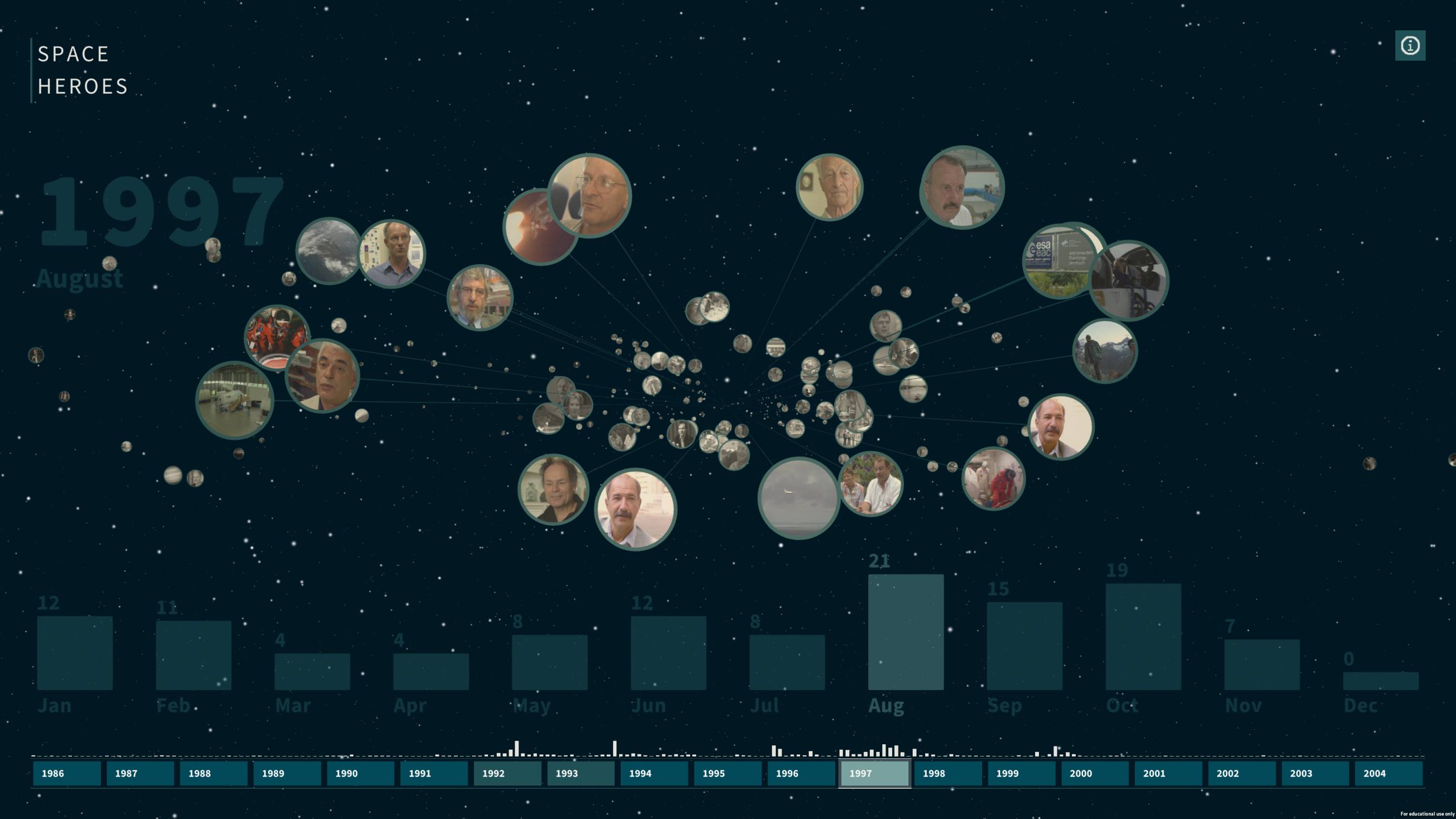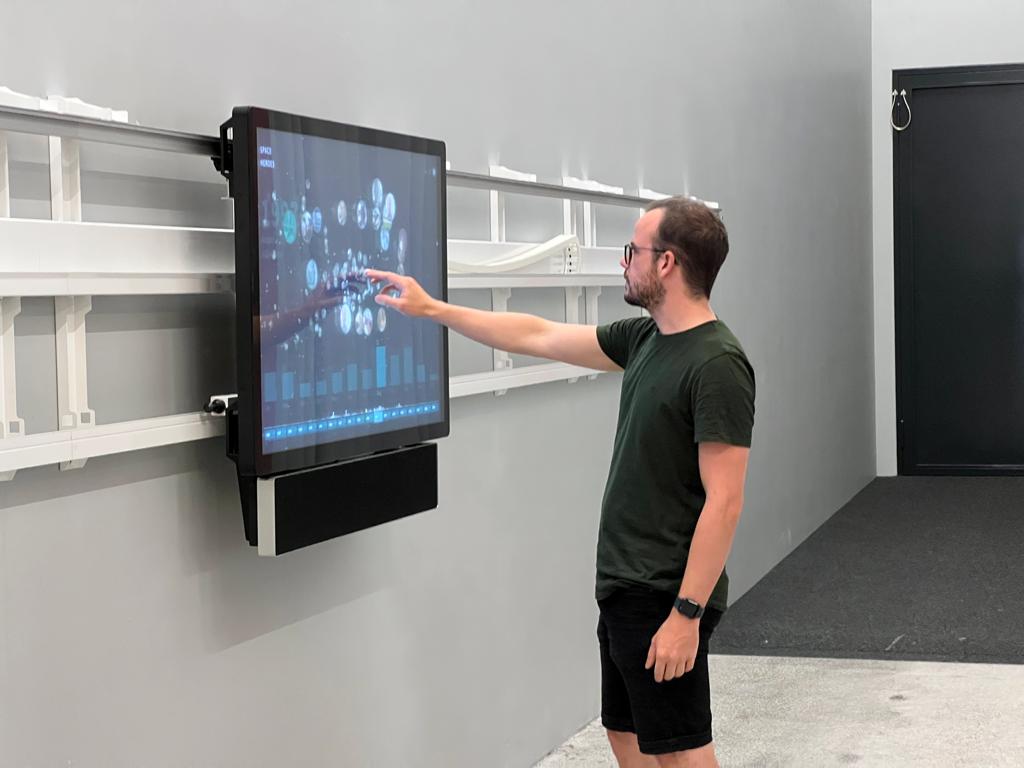Abstract
Space Heroes is an interactive installation developed to explore the Claude Nicollier Video Archive, a collection of videos about the only Swiss astronaut Claude Nicollier. The application is designed for the Linear Navigator, a 4k touch screen mounted on a twelve-meter rail, mapping the timeline of videos to the screen’s physical range of motion. Through this embodied metaphor, users walk along the memories of Nicollier, augmenting their experience with respect to a traditional web-based interface. Participants transduce the archive into a virtual landscape of possibilities through the interface and their embodied interactions with the system. To be presented in a museum exhibition, this installation encourages social interactions between visitors, where one user interacts with the system and drives the narrative for other viewers around. Astrophysics concepts and data are leveraged to reinforce the metaphor of space exploration.
Introduction
Audiovisual archives are increasingly widespread, with large broadcasting institutions digitizing their collections, such as the British Broadcasting Company (BBC) with more than one million hours of footage. Audio and moving image objects are interesting to preserve and document key moments in our history, such as space shuttle launches. Obviously, texts and images can also record such events, but only a video can communicate the tension felt during a launch countdown for instance. Similarly, watching footage from space, and seeing what the astronauts are doing on the International Space Station conveys very strong emotions, as it places the emphasis back on the human in the great adventure of space exploration.
In this context, the Claude Nicollier Video Archive is a wonderful testimony of the life and career of Swiss astronaut Claude Nicollier. Being able to discover how he and his colleagues have trained to become astronauts and then the space missions they have participated in is of crucial importance for our culture and heritage. The amount of work put into the digitization and curation of this collection, therefore, deserves a compelling framework to present it to the larger public. Creating such an engaging installation was our main goal when designing Space Heroes. This interactive installation will be part of the Cosmos Archeology exhibition, to be held at EPFL Pavilions from September 2022 1. The show will feature various media installations that combine astrophysical concepts and artistic ideas, to amaze visitors about the wonders of our universe.
The Claude Nicollier Video Archive

Claude Nicollier is the first Swiss astronaut. Born in 1944, he started his career as a Swiss Air Force pilot before joining the European Space Agency (ESA) in 1976 and later participating in four space missions between 1992 and 1999 with the National Aeronautics and Space Administration (NASA). The archive is a collection of five hundred videos digitized by EPFL’s Cultural Heritage and Innovation Center (CHC). The initiative is the result of two deposits made to the CHC in 2020, the first by Claude Nicollier himself, comprising mostly videos from the NASA and ESA agencies, and the second from Jean-Luc Nicollier, his cousin, with videos he recorded himself, documenting events depicting the astronaut as a family member and friend, and parts of the RTS documentary Destins about the astronaut 2. The CHC has digitized the videos (either internally or through external parties) and documented them through sequences indexing and traditional metadata. Except for some isolated examples, the bulk of videos is from 1986 to 2004, with the majority between 1992 and 1999, corresponding to the most active period of Nicollier as an astronaut.
The installation
Space Heroes is a real-time computer graphics application developed in the game-engine system Unity3D. The application runs on the Linear Navigator, a 4k touch screen mounted on a twelve-meter rail. This system, first developed by Jeffrey Shaw and colleagues in 1999 in Karlsruhe, Germany, has then been adapted and updated through the years3. Videos in the archive are grouped by year and mapped to the range of motion of the Linear Navigator. Within one given year, if there are more than thirty videos, they are further distributed by month, as visible in the figure below. An interactive bar chart shows the number of videos per month for the selected year and allows users to navigate between months, by simply clicking on a bar to move to the corresponding month, along the depth direction (z-axis). Videos are represented by previews in the form of circular thumbnails, the ‘video-planets’, moving along elliptical orbits as most celestial bodies do in our universe. Amongst the video-planets of the selected year, one is always playing, providing an auditory cue to the viewer.

When a video-planet is clicked, the application opens the Full Video mode, where the selected video plays and additional descriptive information such as title and description are displayed, as demonstrated in the next figure. Users are presented with a play/pause button, a video playback speed control, and a scrub bar to navigate the video; crucial controls for videos that are more than three hours long in some cases. Moreover, when someone slides the scrub bar, thumbnails of the corresponding frames in the video appear, as in popular video player systems such as Youtube. This further helps visitors navigate these long and dense videos. The background is a particle-system simulation creating a star field based on the positions of real stars, as they would be seen from Earth.

Finally, when no one is interacting with the system, the Idle mode starts, where a random year is selected and the Linear Navigator moves to the corresponding position, while a visual indicator invites visitors to touch the screen. The Idle mode ensures visitors do not mistake the system for a fixed screen, and by surprising and attracting them when it suddenly starts its motion along the rail.
Augmenting the archive through browsing and embodiment
In response to the recent politics of mass digitization, archival scholars and GLAM professionals have stressed the need for new modes of access to enhance these large digitized collections 4. Space Heroes attempts at solving this issue by proposing a paradigm of access based on the concept of browsing through the archive rather than searching for specific videos, and on the embodied metaphor of walking along with the screen.
First, videos are distributed spatially, horizontally by year, and in-depth by month. Users are therefore invited to pan through the entire archive, only being provided with thumbnails and auditory cues to choose which video to watch. This prompts them to discover the collection bit by bit rather than directly looking for something specific. Such a browsing approach supports serendipitous discoveries5, where visitors can stumble upon content not actively sought after, and better accommodates casual exploration, without clear goals in mind6. Non-specialist audiences might indeed be lost if asked to look for something specific in an archive they might know very little of, and thus browsing rather than searching still allows them to find interesting elements, with a rewarding feeling of being an actor rather than a mere spectator. Their sense of agency is indeed stimulated by the affordances of the system.
Space Heroes further engages the public through the embodied metaphor of walking along the screen. By choosing a year on the bottom timeline of the screen, visitors instruct the Linear Navigator to move to the corresponding position, gradually revealing the contents of the collection and thus acting as both `cameraperson and editor’7. While following the system on its path, users’ physical bodies are directly engaged, providing a more playful interaction than simply standing in front of a fixed screen. Simultaneously, other visitors in the museum space become a sort of audience for the main person interacting with the system8. A certain responsibility is bestowed upon him or her, as it is ultimately their choices that shape the narrative experience for the other people.
Overall, browsing and embodied interactions both contribute to shaping the audiovisual archive as a virtual landscape of possibilities to be explored by the visitors, empowering them to take a more active role in the emergence of narrative. Their choices break down the linearity of time, by jumping from one year to another, reconfiguring the organized structure of the database into a patchwork of Nicollier’s memories, floating in space.
Readers in the region of Lausanne, Switzerland (or passing by) are kindly invited to come to play with Space Heroes and a multitude of other immersive installations to explore our universe through space and time, at the Cosmos Archeology exhibition, held at EPFL Pavilions from September 16th, 2022 to February 5th, 2023, on the EPFL campus.
Notes
- See the EPFL Pavilions website for further details on the exhibition.
- See the RTS website for the full documentary
- Linear Navigator
- Giovanna Fossati et al. 2012. Found footage filmmaking, film archiving and new participatory platforms. Found Footage. Cinema Exposed. Amsterdam:
Amsterdam University Press/EYE Film Institute Netherlands (2012), 177–184. - Elaine G Toms et al. 2000. Serendipitous Information Retrieval. In DELOS.
- Mitchell Whitelaw. 2015. Generous Interfaces for Digital Cultural Collections. (2015).
- Jeffrey Shaw, Peter Weibel, et al. 2003. Future cinema: the cinematic imaginary after film. MIT Press.
- Söke Dinkla. 1994. The history of the interface in interactive art. In Proc. of the 1994 Int. Symp. on the Electronic Arts (ISEA).

